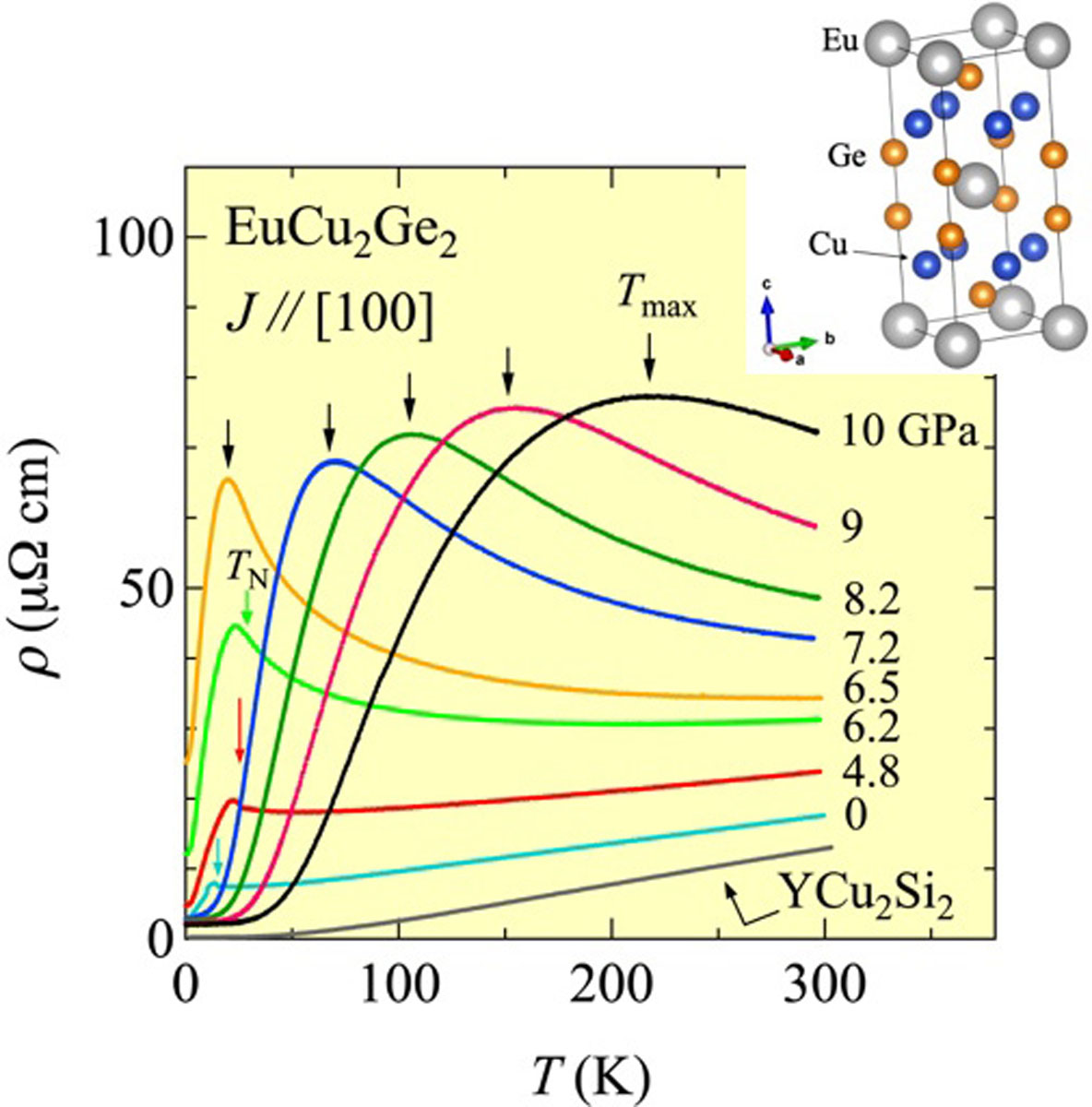Quantum Criticality of Valence Transition for the Antiferromagnetic Compound EuCu2Ge2 under Pressure
Uwatoko Group
Most Eu compounds order magnetically because of a divalent electronic state Eu2+. And, valence instability often occurs in Eu compounds, from the divalent electronic state of Eu2+ at high temperatures to the nearly nonmagnetic electronic state Eu3+ at low temperatures, upon changing the magnetic field and pressure. These compounds can be used to construct a conventional pressure phase diagram with very similar to the Doniach phase diagram for the Ce compounds.
Recently, chemical- and high-pressure measurements have been carried out on single crystals of EuCu2(SixGe1-x)2 with the ThCr2Si2-type tetragonal structure, which undergoes two successive transitions at TN ~ 15 K and T'N ~ 9 K on x = 0, and no magnetic orderings on x = 1, at ambient pressure. TN slightly increases with increasing x and starts decreasing at x = 0.5. and TN disappears around x ~ 0.7, revealing a mixed-valence or valence-fluctuating state.
In this report, we present the results of electrical resistivity measurements under pressure that revealed a new aspect of the quantum criticality on Eu valence transition[1].
Figure 1 shows the temperature dependence of the electrical resistivity ρ of EuCu2Ge2 under several pressures. With increasing pressure, the resistivity at room temperature increases because the c - f hybridization between conduction electrons and 4f electrons is enhanced. TN substantially increases from 15 K and becomes maximum at about 27 K at 6.2 GPa and then it is unclear in a wide temperature region. These results suggest that the valence of Eu increases continuously from nearly divalent to trivalent with increasing pressure. The resistivity at 6.5 GPa indicates no clear magnetic ordering and is typical for a moderate heavy-fermion state. Tmax remains up to 6.5 GPa and shifts to higher temperatures with further increasing pressure.
Figure 2 shows the P vs Néel temperature TN phase diagram of EuCu2Ge2. With increasing pressure, TN substantially increases from 15 K and becomes maximum at about 27 K at 6.2 GPa. The resistivity at 6.5 GPa indicates no clear magnetic ordering. Note that T'N disappears rapidly under pressure. In the present case, the Neel temperature became zero abruptly at around 6.5 GPa. This suggests that the valence of Eu increased continuously up to 6.2 GPa, and then the quantum critical point(QCP) of the valence transition arises abruptly at around Pc = 6.5 GPa. The electronic specific heat coefficient, estimated from the generalized Kadowaki-Woods plot, was about 510 mJ/(mol K2), suggesting that the effective mass of the quasiparticles is highly enhanced around Pc. From the analysis of the pressure effect on the exponent n of the power law dependence of the resistivity: ρmag = ρmag0 + BTn, the fit of the power law to the resistivity data provides valuable information on the pressure dependences of the exponent n of EuCu2Ge2. It is predicted that n reaches 1.5 for the AF-QCP, while it reaches 1 for the QCP of the valence transition. Inset of Fig. 2 shows the pressure dependence of exponent n. In the magnetic region n is larger than the Fermi liquid value n = 2, probably due to electron-magnon scattering. Approaching Pc, the exponent n decreases as a function of pressure and approaches n = 1. It suggests that the case can be explained as QCP of the valence transition while the scenario based on critical AF-QCP cannot be applied to the present case [1]. This is the first observation of this phenomenon among the Eu compounds.
References
- [1] J. Gouchi, K. Miyake, W. Iha, M. Hedo, T. Nakama, Y. Onuki, and Y. Uwatoko, J. Phys. Soc. Jpn. 89, 053703 (2020).


